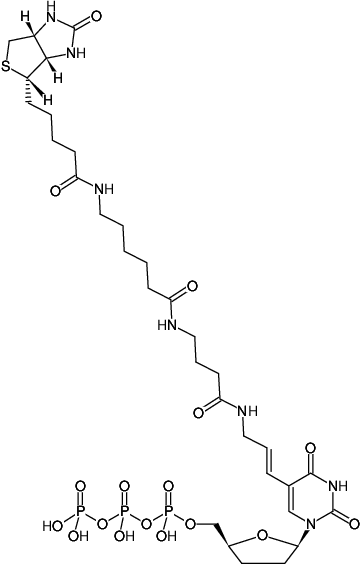Biotin-16-(5-aminoallyl)-ddUTP
Biotinyl-ε-aminocaproyl-γ-aminobutyryl-5-(3-aminoallyl)-2',3'-dideoxyuridine-5'-triphosphate, Triethylammonium salt
| Cat. No. | Amount | Price (EUR) | Buy / Note |
|---|---|---|---|
| NU-253-BIO16-S | 25 μl (1 mM) | 91,80 | Add to Basket/Quote Add to Notepad |
| NU-253-BIO16-L | 5 x 25 μl (1 mM) | 335,50 | Add to Basket/Quote Add to Notepad |

For general laboratory use.
Shipping: shipped on gel packs
Storage Conditions: store at -20 °C
Short term exposure (up to 1 week cumulative) to ambient temperature possible.
Shelf Life: 12 months after date of delivery
Molecular Formula: C32H52N7O17P3S (free acid)
Molecular Weight: 931.78 g/mol (free acid)
Exact Mass: 931.24 g/mol (free acid)
CAS#: 188755-42-2 (Tetralithium salt), 748750-05-2 (free acid)
Purity: ≥ 95 % (HPLC)
Form: filtered solution (30 kDa) in 10 mM Tris-HCl
Color: colorless to slightly yellow
Concentration: 1.0 mM - 1.1 mM
pH: 7.5 ±0.5
Spectroscopic Properties: λmax 240/289 nm, ε 10.7/7.1 L mmol-1 cm-1 (Tris-HCl pH 7.5)
Applications:
BIOZ Product Citations:
Selected References:
[1] Jahn et al. (2011) Functional patterning of DNA origami by parallel enzymatic modification. Bioconjugate Chem. 22:819.
[2] van de Vliet et al. (2009) Highly polymorphic microsatellite markers for the short-snouted seahorse (Hippocampus hippocampus), including markers from a closely related species the long-snouted seahorse (Hippocampus guttulatus). Conservation Genet. Resour. 1 (1):93.
[3] Tengs et al. (2007) Microarray-based method for detection of unknown genetic modifications. BMC Biotechnology 7 (1):91.
[4] Mengel-Jørgensen et al. (2005) Typing of multiple single-nucleotide polymorphisms using ribonuclease cleavage of DNA/RNA chimeric single-base extension primers and detection by MALDI-TOF mass spectrometry. Anal. Chem. 77 (16):5229.
[5] Okada et al. (2004) Contribution of the second OB fold of ribosomal protein S1 from Escherichia coli to the recognition of TmRNA. Biosci. Biotechnol. Biochem. 68 (11):2319.
[6] Liebisch et al. (2003) Value of comparative genomic hybridization and fluorescence in situ hybridization for molecular diagnostics in multiple myeloma. British Journal of Haematology 122:193.